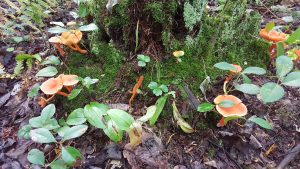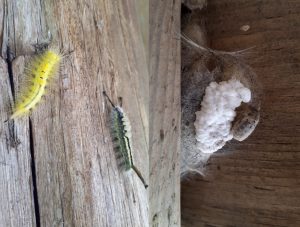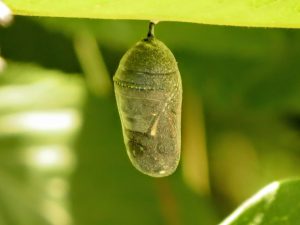Sign vandalism continues to be the biggest management issue at our newest acquisition, the Ron Reid Nature Reserve, as some of the hunters in the area let us know of their presence. While we are not anti-hunting, we do believe that having protected areas for wildlife is important, and therefore do not allow hunting on Conservancy properties.
Melanie and Al Tuck are the General Property Monitoring team for the terrestrial area of the Ron Reid Reserve, and discovered this sign damage September 28th. We are grateful for the tremendous work they are doing to steward this large property.
We’re equally lucky to have Janet Grand & Ron Reid monitoring the aquatic section of the property. Janet and Ron canoe the 4 kilometre stretch of the Black River within our property boundary, keeping an eye out for basking reptiles, and other unique plants & animals.
We plan to add two frog call monitoring teams to this property in 2019. Due to the somewhat remote location, these will be daytime surveys only (no after dark visits will be required). If you think you are up to the task, contact Dorthea at the office.

Holly Brown and Eileen Atkinson are the General Property Monitoring Team for the Adams Nature Reserve and made their first visit as a team on September 19th.
While there wasn’t much in bloom, there also weren’t any mosquitoes and the temperature was perfect.
Holly and Eileen are both interested in the plants, so in addition to their reports on trail conditions, human incursions, and anything else that might need maintenance, we’re looking forward to seeing what sort of plant inventory they gradually build for the property.
The Adams Nature Reserve property unveiling was a mere 11 months ago, and we still have much to learn!

One of these things is not like the others. A Red Eft Newt blends perfectly with mushrooms at the T.C. Agnew Nature Reserve.
Meagan and Dorthea couldn’t wait any longer to see if any of the snapping turtles we told you about in June had hatched yet (they have), and took an extended tour of the trail system. They saw a garter snake, Midland Painted Turtle, a Valley of Giant Mushrooms, and this Newt in the Red Eft stage.
Newts in this stage become terrestrial for a few years, before becoming adults and returning to the aquatic environment to mate.
-September 11, 2018

Volunteers Karl, Alan, and Mike have been installing a fence around the new parking area and trailhead at the Ron Reid Nature Reserve. This photo was taken during humidex conditions of 40 degrees!
Have you registered yet to attend the Ron Reid Nature Reserve property dedication on Saturday September 16th? All the details here
-September 6, 2018

Grant’s Woods experienced a rare streak of vandalism recently. In June the heavy plexi on the brochure rack was smashed. Then yesterday someone cut the lock off the donation box.
Since we clean out the donations very regularly, the vandals got very little money, if any, for their trouble.
-September 6, 2018

A female Bobolink on Bluebird Ranch, Carden. Bobolink have by now fledged their young and are feeding up and departing for the long trip to the Pampas grasslands of South America.
Bobolink are a Species-at-Risk in Ontario and listed as “Threatened”. The main threat to their species in our province is the loss of grassland habitat, and mowing of hay during their breeding period. Along their migration route and in their wintering areas in South America, Bobolink are considered a pest of grain crops.
The Couchiching Conservancy produced a booklet to assist farmers in managing their hay and pastures for grassland birds which you can read here
-September 5, 2018

Road safety versus fish in Sundial Creek: We’ve been working with the City of Orillia, concerned neighbours, and Patrick Fogarty students on a problem weighing heavily on us all. Minutes from downtown Orillia, there’s a cold water stream that supports Brook Trout, but we’re not sure how long it will continue to do so.
Those long icy winters require sand and salt to keep us safe on the roads, and all that material eventually washes into the ditches, and the ditches in turn merge with streams and are carried into the lakes.
At this point, the lower reaches of Sundial Creek have become so choked with sand, that all interested parties have banded together to work on solutions. Those solutions won’t be easy, and likely won’t be cheap, but a cold water stream in the heart of the city is priceless.
Thanks to the City of Orillia staff, Environmental Advisory Committee, and Council, for your continuing commitment to find a solution. – Wednesday August 22nd, 2018

There was no time to get a picture of the bear, so instead Gerry Church offers you this photo of some Mushrooms and a good story…
“Whenever I go out to the Kris Starr Sanctuary, I always walk the North side first and I found the trail well-used. Just as I was about to start heading south back to the Monck Road, I heard some scraping sounds and looked up to find a black bear trying to climb a dead tree. At the same time, two partridge exploded out from under the pine trees.
There we were looking at each other, the bear peeking around the tree about two feet off the ground.
I discreetly walked backward down the trail and once out of sight footed back to the highway with nothing following me. I do carry a Bear Banger with me, but have never used it yet. This is the second time in my life that I have met a bear in the bush.” – August 19, 2018
-Gerry Church is one of the volunteer property monitors for the Kris Starr Sanctuary.

Around the office we are all going a little bit crazy for the Moth and Butterfly metamorphosis currently taking place. This strange sight in the gazebo at Grant’s Woods didn’t help our obsession. After a bit of investigation, “Murdoch Hawke” (Stewardship Manager Dave Hawke), solved the mystery:
These brightly marked caterpillars are the Definite Tussock Moth and the White-marked Tussock Moth. They wander around eating tree leaves, then spin a cocoon in a sheltered area (such as the Grant’s Woods gazebo where there are about a dozen at the moment).
When they emerge a few weeks later as an adult moth, the males fly while the females can’t as they have tiny wings no good for flying. The females immediately attract a flying male and mating takes place right on the recently exited cocoon. The eggs are laid on the cocoon and covered with a frothy coating. The adults die, and stay stuck to the eggs that are in turn glued to empty cocoon until hatching next spring.
Note: Caterpillar hairs may cause allergic reactions if they come in contact with sensitive skin. This includes the coccoon.
July 31, 2018

All over our region, the metamorphosis of caterpillar into butterfly is taking place.
After eating their way through the leaves of plants they were born onto, caterpillars then hang from twigs, leaves, or buildings, and either spin a cocoon or molt in a chrysalis.
Within the chrysalis, the old body parts of the caterpillar are transforming into a butterfly.

When ready, the butterfly emerges, rests for several hours, pumps blood into their wings and flies away. To complete the lifecycle, butterflies will lay eggs on plants the caterpillars like to eat sometime in early summer.
Generally speaking, if a caterpillar is hairy it will become a moth, and if smooth will become a butterfly. – July 30, 2018
These photos were taken at the Ron Reid Nature Reserve during a recent Passport to Nature event.
July 30, 2018

